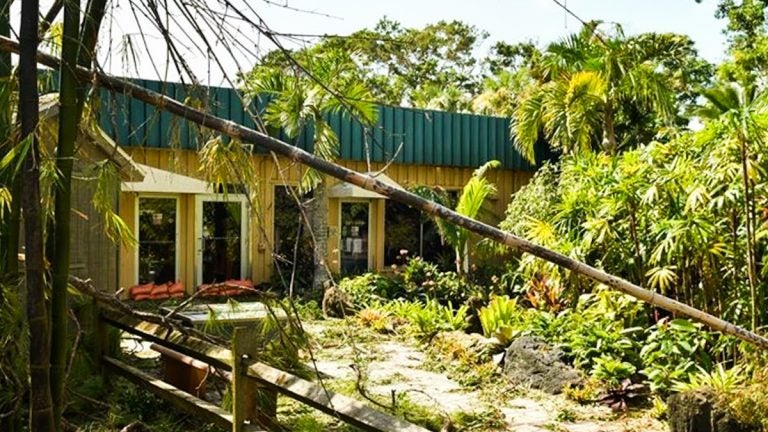When zoo animals evacuate, where do they go?
Getting 161 animals to safety requires choreography and cooperation.
Listen 0:00
The entrance of the Naples Zoo shortly after Irma hit. (Courtesy of Courtney Jolly)
Hurricane Irma ripped through the Naples Zoo about a week before I visited in September. When I arrived, rebuilding efforts were in full force.
As zoos go, this one is pretty small. You can visit just about all of the animals in a one-mile stroll. But what it lacks in size, it makes up for in tropical beauty. The zoo has always been known for its graceful tree cover almost as much as its animals. That is, until Irma struck.
The storm hit land with wind speeds of more than 100-miles an hour, ripping tall palms up by their roots. Irma blew away the macaw cages, and left walking paths under two feet of water.
Two animals died. They were antelopes called greater kudu. They couldn’t take the stress of the storm. But all 161 of the other animals did okay.
“We kept the carnivores here, in hurricane-proof buildings: the tigers, the leopards, the cheetahs, the bears, the hyena,” says zoo President Jack Mulvena.
This is southwest Florida, after all, prime hurricane territory. So, the zoo has every kind of emergency plan in place. The staff had been prepping for weeks before, back when Irma was just a whisper. But the storm grew.
The big concern was the storm surge: a rush of water coming behind the hurricane. Staffers carefully crated up the smaller animals and placed them in hurricane-proof shelters. But they worried that a wall of water would overtake and drown the animals.
“Given the fact that the storm surge continued to increase, and at one point at the end, they were saying it could possibly be 10- to 15-feet — that covers most of our holding buildings — so we made a decision, rightfully so, on Saturday morning to evacuate 89 of our crated animals,” Mulvena says.

So where do you go with 89 zoo animals? You take them to Nancy Jane Tetzlaff Behrens’ house. Her home is inland and was a much safer bet.
Tetzlaff’s late husband was a part-time movie actor known as Jungle Larry (she was Safari Jane). Together, they founded the collection of animals that now makes up the Naples Zoo.
Director of Animal Programs Liz Harmon oversaw the evacuation to the Tetzlaff home.
“We actually had a system,” Harmon says. “We had the primates on one side of the garage, we had the carnivores on the other side of the garage. We had the tortoises kind of down the middle.”
So how did that all go?
“They were actually very calm. It was kind of eerie how close quarters they were, and smelling their predators, and animals they hadn’t smelled before.
And they were actually all very calm, very polite when we would hand them food. So everybody worked out really well. I guess it’s sort of like people, when a storm’s coming, you know how everyone’s nice to who they’re not always nice to before? I kind of think it affects animals maybe the same way.”
Just a few days after the storm, the staff had cleared enough space to get all the animals back in their enclosures. And by the end of that first week, the keepers say the animals were starting to feel comfortable again, including the siamang gibbons.
They’re dark-haired primates with concerned faces and large pouches at their throats that give them serious vocal power. They began to sing again.
Meanwhile, staffers turned to the enormous task of restoring the zoo’s landscape.
Director of Gardens and Grounds Danielle Green says, “Our tree cover here is probably 25 percent gone. We’ve lost some specimens. We had a Royal Palm that was nearly 100 years old. The head snapped off. It took us a few days to find it.”

As her team digs into the overwhelming job of clearing the downed trees and repairing structures, they are taking their cue from the animals.
“These guys are amazing,” she says. “They seem to have gotten back to normal quicker than I would have ever imagined. Uno, our Florida panther, was out in his habitat yesterday after we were able to get debris and mend some fences.
It seemed to me that this was the first day of normalcy for a lot of us to see him, resting in his normal spot, looking calm. It makes us feel calm, that we’re getting close. Every day we’re getting closer.”
WHYY is your source for fact-based, in-depth journalism and information. As a nonprofit organization, we rely on financial support from readers like you. Please give today.






